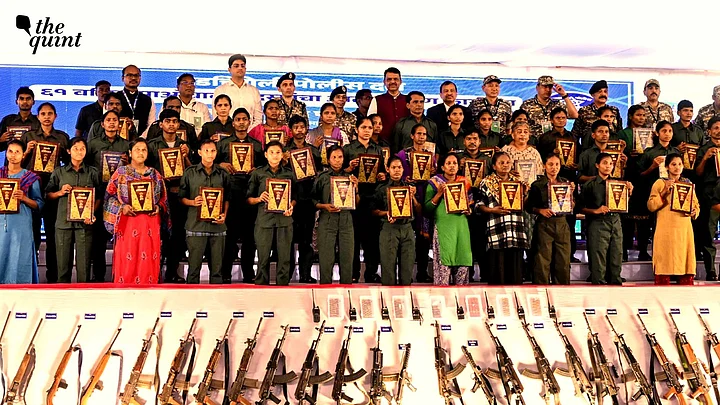The "Surrender Ceremony" of non-state armed militia in India was once a numbers game, connected to citations and awards given by the state to the security forces. It was a happier congregation in an otherwise volatile zone. It served the political class as well as the security forces and the militia—to some extent. A rose for a gun was the usual exchange on stage.
At Gadchiroli on 15 October, Maharashtra Chief Minister Devendra Fadnavis replaced the rose with a copy of the Constitution, handing them out to 61 Maoist guerillas, in what could be one of the most decisive surrenders yet. Top leader Mallojula Venugopal Rao alias Bhupati, who is also a Central Committee member of the CPI (Maoist), led the "ceremony".
Two days later, 210 cadres—including 110 women—led by another leader, Rupesh, gave up arms in Bastar at ‘Puna Margem’, a surrender ceremony in Chhattisgarh. They, too, got a copy of the Constitution and a rose.
Operation Kagar
This marks a critical phase for the Indian state, which launched Operation Kagar or Operation Zero against Maoists or Left Wing Extremists (LWE) in Chhattisgarh, with the aim of “wiping out” long-running armed violence in the mineral-rich tribal region. Almost 10,000 Indian soldiers were engaged in this war in the centre of the country, with several thousand more police personnel deployed across two states.
India’s war against the Maoists or Naxals is now more than half a century old. The insurgency sustained itself through splits and mergers across several states, establishing “liberated zones” in vast, uninhabited, and ungoverned space. There have been long phases of passive resistance and violent, fratricidal divisions within the fold, but they managed to regroup and strike at a time and place of their choosing. Will this mark a real shift in armed underground violence in India?
Home Minister Amit Shah’s pledge to wipe out the Maoist movement may well be fulfilled before the deadline of April 2026. Bhupati’s defiance—or betrayal—against the party and his surrender may be the closest the Indian state has come to strike the final blow. As the ideological head and number two in the organisation, Bhupati’s decision could mark a turning point.
He was also a member of the central military commission, led by Tirupati, who has been appointed the next party general secretary, following the killing of Nambala Kesava Rao in an encounter this year. Bhupati was associated with the CPI (Maoist) for nearly 45 years, with 28 years in the Politburo. He exerted significant influence over the divisions in Bastar and Gadchiroli.
The Secret Deal
Weeks of disagreements within the top leadership and days before his surrender, the party had reportedly made Bhupati agree to float a left-wing political party. There is no clarity on why he decided to surrender in Maharashtra instead of Chhattisgarh, where the government had agreed on a 12-point deal.
However, these two surrenders have now paved the way for lifting the ban on the Moolvasi Bacchao Manch, an Adivasi collective, and for the release on bail of its members. Sources among the surrendered leaders say a roadmap for the of the Forest Rights Act (FRA) and the Panchayats (Extension to Scheduled Areas) Act (PESA) has been promised. The government is also expected to release undertrials and convicts in Maoist cases in Chhattisgarh jails, and to provide them with livelihood support.
So, where will the movement go from here? It is true that internal party reports indicate declining recruitment, shrinking units, and shortage of ammunition.
But the dreaded Battalion 1 of the Maoists is still at large and their arms and cadres have so far managed to escape Operation Kagar. Hidma, the Maoist Adivasi leader, says he is observing developments but wants to understand what they will mean for Adivasis at large. Bhupati, meanwhile, alleges that the Telangana government is helping the unit stay alive.
Resources and Resistance
Even if a military solution clears out the zones Amit Shah has targeted, the ideology will demand a fresh approach—one that India may not be able to afford. A populous and energy-hungry country will not easily relinquish the natural resources that lie at the heart of this mass resistance.
The 2011 Census puts the Adivasi population in Chhattisgarh at about one-third of the state’s 25.5 million people. Chhattisgarh alone has 117 mines, and Bastar is among the richest mineral zones—yet infant mortality remains far higher than the national average, and poverty levels hover around 80 percent. There are contesting estimates of the number of displaced tribals but it is anywhere between 50,000 to 100,000, collateral damage of mining and military operations.
It has been the limitations of Indian democracy: balancing development and social justice, growth and displacement, rights and resources, environment and sustainability, and security of the people against the notion of “national security.”
Addressing a global audience on a private network owned by a mining conglomerate with interests in the Adivasi heartland, Prime Minister Narendra Modi said on Friday, "In the last 50-55 years, thousands were killed by Maoist terrorists. These Naxals would not allow schools or hospitals to be built...they would not let doctors enter clinics...they would bomb institutions. Maoist terrorism was an injustice to the young people."
He claimed this is the first time he has mentioned the Maoist insurgency to world leaders. "This Diwali”, he added, “will be different in the areas freed from Maoist terror. Mothers will see the festival of lights after 25 or even 50 years. The tricolour will fly there, and the lamps of happiness will burn once again," he said.
"That day is not far when the country will be completely free from Naxalism, from Maoist terror. And this too, this too is Modi's Guarantee."
(Kishalay Bhattacharjee is Dean, Jindal School of Journalism and Communication and author most recently of Where the Madness Lies: Citizen Accounts of Identity and Nationalism (Orient Black Swan). This is an opinion piece. All views expressed are the author’s own. The Quint neither endorses nor is responsible for them.)
